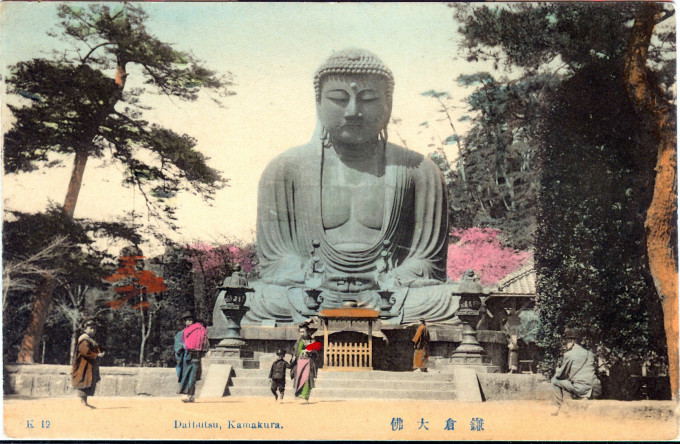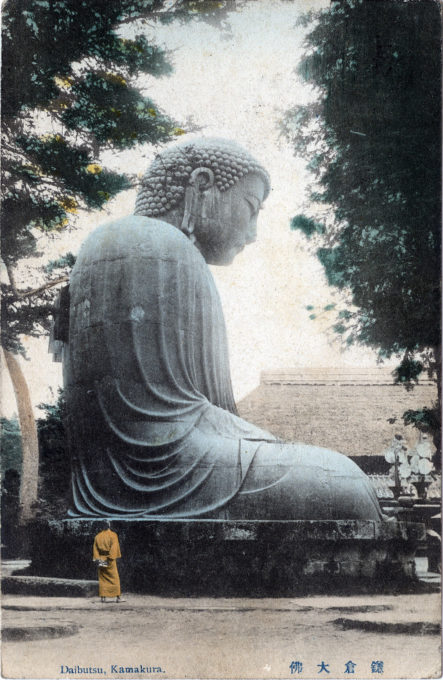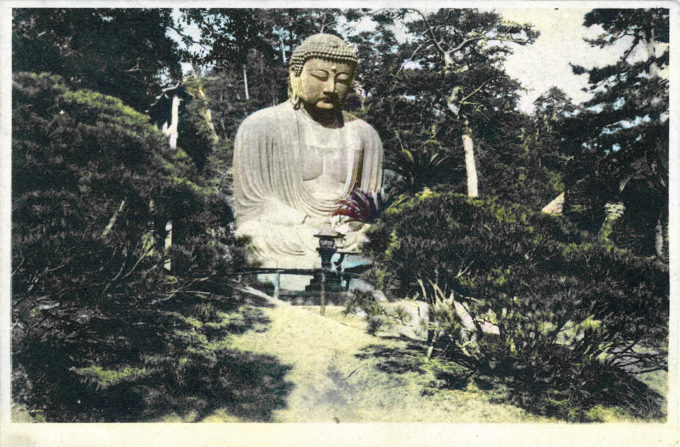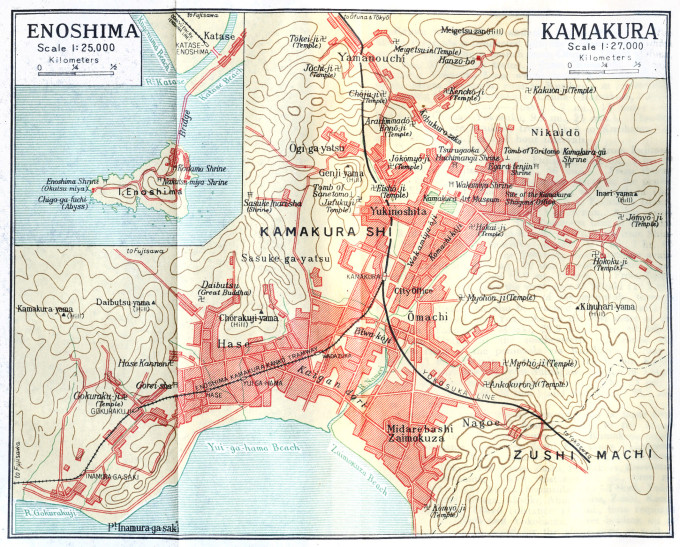See also:
Daibutsu at Ueno Park, Tokyo, c. 1910.
Daibutsu, Nara, c. 1920.
To him the Way, the Law, Apart,
Whom Maya held beneath her heart,
Ananda’s Lord the Bodhisat,
The Buddha of Kamakura.
… But when the morning prayer is prayed,
Think, ere ye pass to strife and trade,
Is God in human image made
No nearer than Kamakura?
– “The Five Nations: Buddha at Kamakura”, Rudyard Kipling, 1903
“Kōtoku-in is a Buddhist temple of the Jōdo-shū sect in the city of Kamakura in Kanagawa Prefecture, Japan. The temple is renowned for its ‘Great Buddha’ (Daibutsu), a monumental outdoor bronze statue of Amida Buddha which is one of the most famous icons of Japan. The bronze statue probably dates from 1252, in the Kamakura period, according to temple records.
“It was preceded by a giant wooden Buddha, which was completed in 1243 after ten years of continuous labor. That wooden statue was damaged by a storm in 1248, and the hall containing it was destroyed, so Jōkō suggested making another statue of bronze, and the huge amount of money necessary for this and for a new hall was raised for the project. It is unclear, however, whether the statue constructed in 1252 is the same statue as the present statue.
“The hall was destroyed by a storm in 1334, was rebuilt, and was damaged by yet another storm in 1369, and was rebuilt yet again. The last building housing the statue was washed away in the tsunami of September 1498, during the Muromachi period. Since then, the Great Buddha has stood in the open air.
“The statue is approximately 13.35 meters tall including the base and weighs approximately 93 tonnes. It is hollow, and visitors can view the interior. A notice at the entrance to the grounds reads, ‘Stranger, whosoever thou art and whatsoever be thy creed, when thou enterest this sanctuary remember thou treadest upon ground hallowed by the worship of ages. This is the Temple of Bhudda [sic] and the gate of the eternal, and should therefore be entered with reverence.'”
– Wikipedia
“This huge bronze statue of Amida popularly known as the Great Buddha of Kamakura was made in about 1252. That it is not Rushana (Vairochana Buddha), as is the case of the Daibutsu in Nara, but is the Amitabha Buddha is typical of Kamakura.
“While the Nara Buddha was built by an Imperial order heavily taxing the national exchequer, the Daibutsu of Kamakura was planned by an obscure Buddhist monk supported by public sympathy and this reflects the spirit of the age. The name of the castor is known – Tanji Hisatomo – but the name of the maker of the original model is lost.
“As the great masterpiece reflecting the realistic tendency of the time, the statue has an air of democratic approach-ability and symbolises infinite love. It is an eminently successful work.”
– Handbook of the Old Shrines and Temples and Their Treasures in Japan, published by the Bureau of Religions (Department of Education), 1920






Pingback: japon vintage | tokyo fever
Pingback: Kamakura Station, c. 1910. | Old Tokyo
Pingback: Daibutsu, Nara, c. 1920. | Old Tokyo
Pingback: Engakuji Temple, Kamakura, c. 1940. | Old Tokyo
Pingback: Grand Hotel, Yokohama, c. 1910. | Old Tokyo